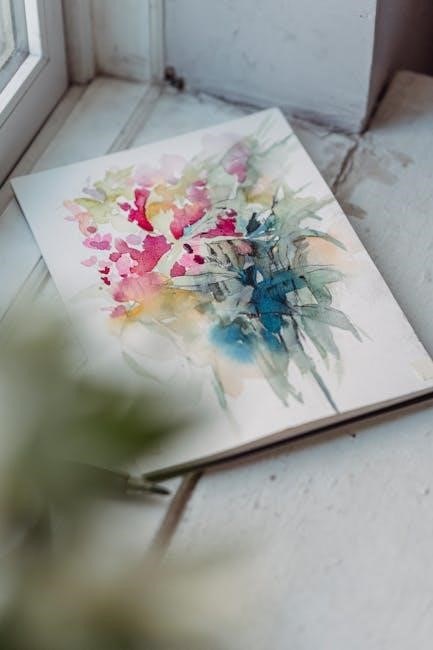Watercolor painting is a versatile and fluid artistic medium offering endless creative possibilities. Its translucent and adaptable nature allows artists to capture stunning landscapes, delicate illustrations, and expressive designs. Discover its unique techniques and resources through comprehensive PDF guides and tutorials.
Overview of Watercolor Painting
Watercolor painting is a captivating and expressive art form known for its fluidity and transparency. It allows artists to create delicate, luminous washes and vibrant hues, making it ideal for capturing landscapes, portraits, and abstract designs. The medium’s versatility enables both subtle, layered work and bold, spontaneous strokes. Unlike oil or acrylic painting, watercolor relies heavily on water-to-pigment ratios, requiring precise control to achieve desired effects. Its unique blend of unpredictability and precision makes it a favorite among artists of all skill levels. Whether used for intricate details or broad, ethereal compositions, watercolor painting offers endless creative possibilities. Its portability and simplicity make it accessible, while its depth and complexity challenge even seasoned artists. With proper techniques and materials, watercolor painting can produce breathtaking works of art, from soft, dreamy skies to vivid, lifelike botanicals. This medium continues to inspire artists worldwide, fostering a community dedicated to mastering its timeless beauty.
History and Evolution
Watercolor painting traces its origins to ancient civilizations, with evidence of its use in Egyptian papyri and Chinese landscapes dating back thousands of years. The medium evolved significantly during the Renaissance, becoming a popular choice for sketching and preliminary studies. By the 18th and 19th centuries, watercolor gained prominence as a standalone art form, particularly in England, where artists like J.M;W. Turner revolutionized its use with bold, expressive works. The 20th century saw further innovation, blending traditional techniques with modern artistic movements. Today, watercolor remains a beloved medium, celebrated for its versatility and timeless appeal. Its evolution reflects the creativity and adaptability of artists across generations, from delicate botanical illustrations to contemporary abstract pieces. This rich history underscores watercolor’s enduring relevance in the world of art.
Unique Characteristics
Watercolor painting is distinguished by its unparalleled translucency and fluidity, allowing for ethereal effects that other mediums cannot achieve. The transparency of watercolor paint enables luminous washes, creating a sense of depth and light that captivates the viewer. Unlike oil or acrylic, watercolor relies on the white of the paper to shine through, giving it a unique radiance. Its fluid nature makes it unpredictable yet versatile, as colors can blend and bleed in unexpected ways. This medium demands precision in water-to-pigment ratios, offering artists the ability to craft delicate, layered compositions. Watercolor’s spontaneity and subtlety require careful planning, as it is challenging to alter once dry. These characteristics make watercolor painting both rewarding and distinctive, allowing artists to express their vision with a blend of control and organic beauty. The medium’s ability to capture fleeting moments and evoke emotion has made it a timeless favorite among artists and art lovers alike.
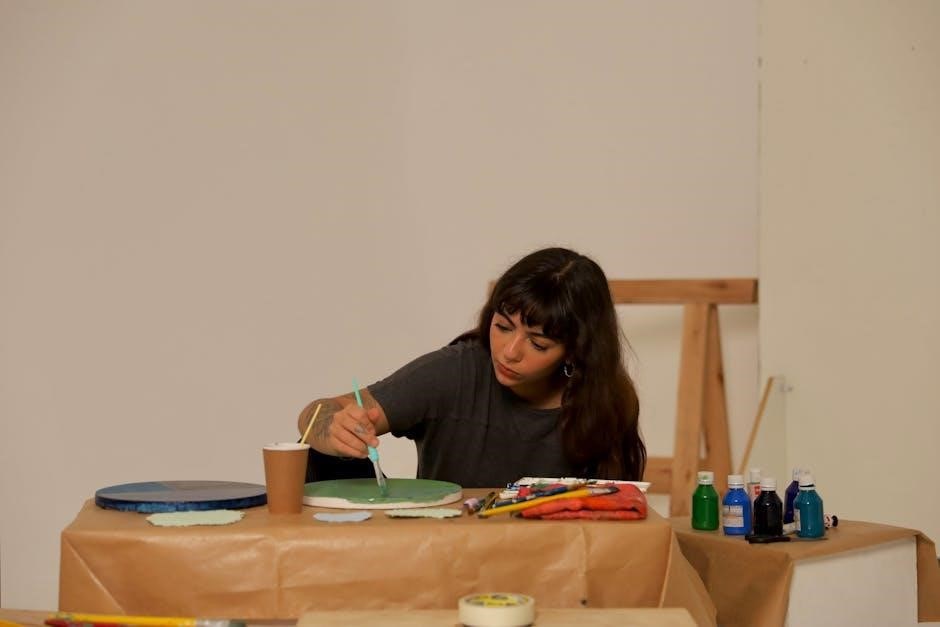
Materials and Tools
Watercolor painting requires high-quality materials, including absorbent paper, versatile brushes, vibrant paints, and essential accessories. These tools empower artists to explore techniques and achieve desired effects, enhancing the creative process and final artwork.
Watercolor Paper
Watercolor paper is a fundamental component of watercolor painting, designed to withstand multiple layers of moisture without buckling or warping. It is typically made from cotton or a mix of natural fibers, ensuring durability and texture. The paper’s weight, usually measured in pounds (lb) or grams per square meter (gsm), determines its strength and absorbency. Heavier papers, such as 300 gsm, are ideal for wet techniques, while lighter sheets may require stretching. The surface texture, available in rough, cold press, or hot press, affects the brushstroke’s appearance. Cold press, the most popular choice, offers a balanced texture for blending and detail. Investing in high-quality watercolor paper is crucial for achieving professional results and preserving artwork over time. Properly prepared paper ensures optimal paint adhesion and longevity, making it a cornerstone of successful watercolor painting.
Brushes
Watercolor brushes are essential tools for achieving desired effects in painting. They come in various sizes, shapes, and fiber types, each suited for specific techniques. Natural fibers, like sable, are prized for their water-holding capacity and precision, while synthetic fibers offer durability and affordability. Round brushes are versatile, excelling at fine details and broad washes. Flat brushes, with their wide heads, are ideal for covering large areas and creating smooth, even strokes. Mop brushes, made from soft fibers, are perfect for blending and creating soft, diffused effects. Detail brushes, such as liners, are designed for intricate work and fine lines. Proper brush care, including regular cleaning and storage, ensures longevity. By selecting the right brush, artists can control pigment flow, texture, and detail, ultimately enhancing the quality and expressiveness of their watercolor paintings. Brushes are a critical investment for any watercolor artist, enabling them to bring their creative vision to life.
Paints
Watercolor paints are available in tubes or pans and come in a wide range of vibrant, light-fast colors. High-quality paints have high pigment loads, ensuring rich, vivid hues. Look for paints labeled as “light-fast” to ensure they won’t fade over time. Professional-grade paints often contain pure pigments and minimal fillers, offering superior transparency and blending. Student-grade paints may have lower pigment concentrations but are more affordable. When selecting paints, consider the binder, typically gum arabic, which helps the pigment adhere to the paper. Some paints also include additives like honey for smoother consistency. Experimenting with different brands and types can help you find the best fit for your style. Understanding color theory and how to mix hues is key to expanding your palette. By investing in quality paints, you can achieve the desired effects and create stunning, long-lasting watercolor artworks. Proper storage and handling will preserve your paints for years of creative use.
Accessories
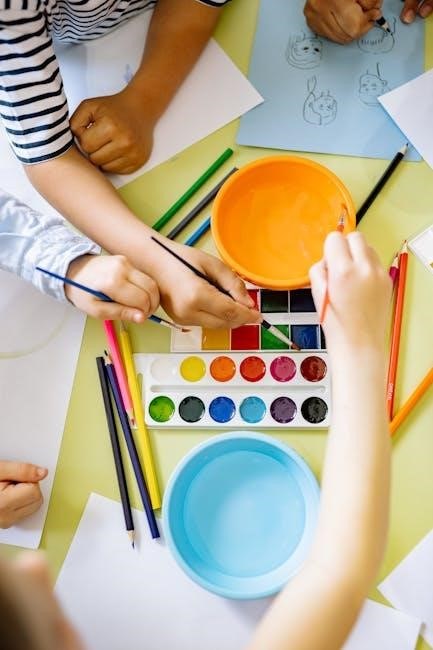
Accessories play a crucial role in enhancing your watercolor painting experience. A masking fluid is essential for protecting areas of your painting from unwanted color, allowing for crisp, white highlights. Palettes, whether plastic or porcelain, provide a space for mixing colors and blending hues. A water container is indispensable for rinsing brushes and creating diluted washes. Rags or paper towels are necessary for blotting excess water from brushes, preventing over-saturation of the paper. Additional tools like spray bottles can help maintain paper moisture, while masking tapes can create sharp edges or borders. Pencils and erasers are vital for sketching compositions, and a kneaded eraser can lift pigment for subtle corrections. Sponges and texture tools can add unique effects to your work. These accessories, while not the primary tools, are integral to achieving precise control and desired effects in your watercolor creations. They complement your brushes, paints, and paper, enabling you to explore the medium’s full potential.
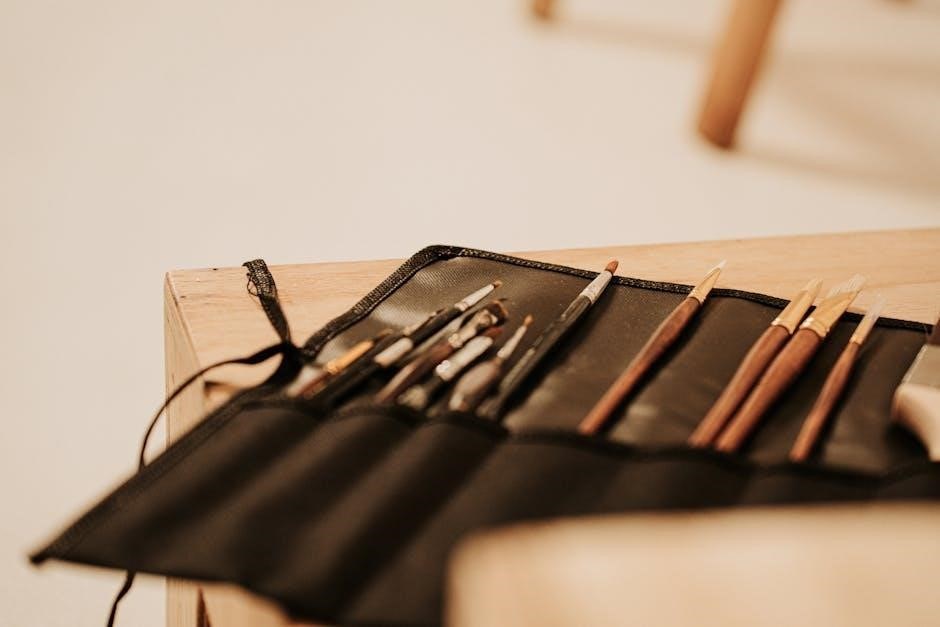
Basic Techniques
Mastering basic watercolor techniques is essential for building a strong foundation. Washes create smooth backgrounds, while wet-on-wet and wet-on-dry methods offer control over blending and edges. Gradated and variegated washes add depth and complexity, forming the core of watercolor artistry.
Washes
Washes are the fundamental building blocks of watercolor painting, providing a smooth and even base for your artwork. A wash involves applying a thin, diluted layer of paint to the paper. The key to a successful wash lies in the consistency of the paint mixture and controlled brush application. To achieve an even wash, use enough water to dilute the paint to the desired transparency. Load your brush with paint and move it consistently across the paper. Practice is essential for mastering this technique. Washes can be used to create subtle transitions of color or bold statements of hue, making them versatile for various artistic expressions. Proper execution ensures a streak-free and uniform background, ready for further layering and detail work. This technique is timeless and essential for every watercolor artist, forming the foundation for more complex compositions.
Wet-on-Wet
The wet-on-wet technique in watercolor painting involves applying paint to wet paper, allowing colors to blend seamlessly. This method creates soft, diffused edges and fluid transitions, perfect for capturing ethereal elements like skies, water, or atmospheric effects. To master wet-on-wet, work quickly, as the paint dries rapidly. Understanding how colors interact when wet is crucial, as they can bleed unpredictably. A light touch with the brush and working from darker to lighter hues helps control the blending process. This technique is ideal for achieving a sense of movement and fluidity, making it a cornerstone of watercolor art. Practice is key to harnessing its full potential and creating stunning, dynamic pieces that reflect the medium’s unique qualities.
Wet-on-Dry
Wet-on-dry is a watercolor technique where paint is applied to dry paper, allowing for sharp edges and precise details. This method is ideal for creating defined shapes, fine lines, and realistic elements like botanicals, portraits, or architectural details. To achieve wet-on-dry, ensure the paper is completely dry before applying paint. Load your brush with paint and work with controlled strokes to maintain clarity. Thin washes can be layered gradually to avoid harsh lines. This technique offers greater control, making it suitable for intricate work and representational art. Unlike wet-on-wet, wet-on-dry provides crisp boundaries, enabling artists to achieve accuracy and detail effortlessly. It’s a fundamental method for building up layers in a painting, ensuring each element is distinct and well-defined. Mastering wet-on-dry enhances your ability to capture the subtleties and complexities of your subjects with precision and clarity.
Gradated Washes
Gradated washes are a foundational watercolor technique that creates smooth transitions of color, from dark to light or vice versa. This method involves gradually diluting the paint with water as you apply it, resulting in a seamless blend of hues. To achieve this, start with a concentrated wash at one end and slowly add more water as you move across the paper. This technique is particularly effective for capturing atmospheric effects, such as soft skies or distant landscapes. Gradated washes add depth and dimension to your artwork, creating a sense of realism and visual interest. They are versatile and can be used to depict subtle shifts in color, such as the fading light of dawn or the gentle blending of foliage. By maintaining a consistent flow of water and paint, you can ensure smooth, natural transitions. Practice this technique to master the art of creating harmonious, graduated color shifts in your watercolor paintings.
Variegated Washes
Variegated washes introduce a dynamic and expressive element to watercolor painting by blending multiple colors within a single wash. This technique creates a captivating interplay of hues and textures, adding visual interest and complexity to your artwork. Unlike gradated washes, which focus on smooth transitions, variegated washes embrace unpredictability. To achieve this effect, mix different colors on your palette or directly on the paper, allowing them to mingle naturally. Tilting the paper or using a damp brush can enhance the blending process, resulting in unique patterns and textures. Variegated washes are particularly effective for depicting natural elements like skies, water, and foliage, where subtle color variations enhance realism. This technique encourages experimentation, as the interaction of colors can produce unexpected yet harmonious results. By mastering variegated washes, you can add depth and vibrancy to your watercolor paintings, making them stand out with their dynamic and expressive quality.
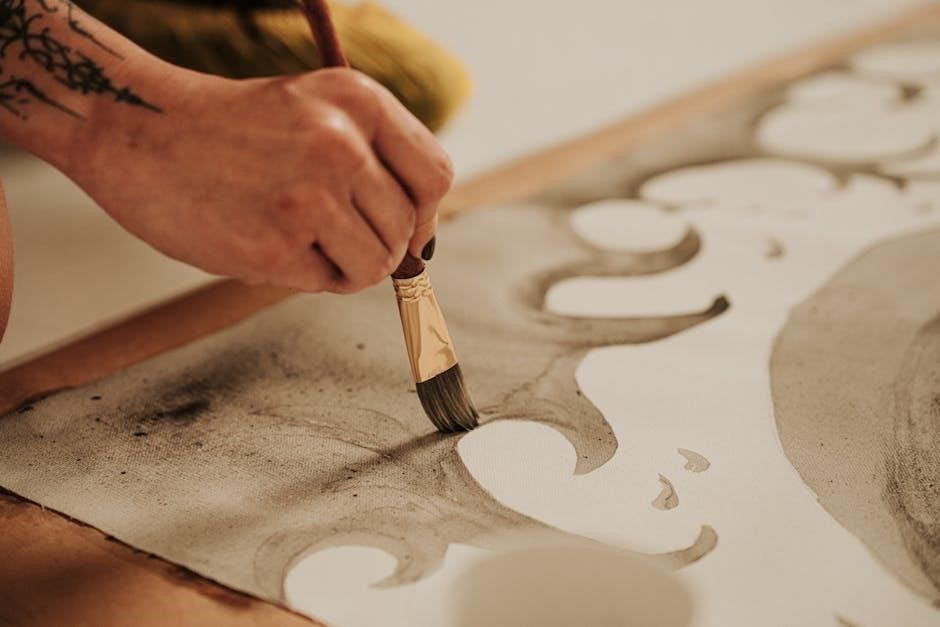
Practical Exercises
Master watercolor through hands-on exercises: color mixing, basic washes, simple compositions, and detail work. These exercises build foundational skills and confidence, allowing artists to explore the medium effectively.
Color Mixing
Color mixing is a fundamental skill in watercolor painting, enabling artists to create a wide range of hues and shades. By understanding primary and secondary colors, you can craft custom palettes. Start with basic color theory, experimenting with water-to-pigment ratios to achieve desired transparency and vibrancy. Practice mixing complementary colors to produce rich neutrals and muted tones. Gradient washes are an excellent exercise for observing how colors blend and transition. Create a color wheel to visualize harmonies and contrasts. This exercise helps in understanding color relationships and enhances your ability to mix precise shades. Regular practice with color mixing will refine your technique, allowing you to achieve consistent results and expand your artistic expression.
Basic Wash Application
Mastering the basic wash is essential for watercolor painting. A wash involves applying a thin, diluted layer of paint to the paper, creating smooth, even backgrounds or subtle color transitions. Start by loading your brush with paint and mixing it with water on your palette. For a flat wash, apply the paint in even, horizontal or vertical strokes, maintaining consistent water-to-pigment ratio. Ensure the paper is dry before starting to avoid unintended blending. Gradually build up layers, allowing each wash to dry completely before adding more. Practice on scrap paper to achieve uniformity and avoid streaks. This technique forms the foundation for more complex compositions, allowing you to establish tone and mood in your artwork. Regular practice will enhance your control and confidence in applying washes effectively.
Simple Compositions
Creating simple compositions is a great way to refine your watercolor skills while focusing on essential techniques. Start with basic subjects like skies, trees, or flowers, using wet-on-wet and wet-on-dry methods. Begin by sketching your design lightly on paper, then apply washes to establish the background. Use natural elements to add texture and depth, such as tree branches or foliage, which can be achieved with quick, expressive brushstrokes. For water or skies, employ gradated washes to create soft transitions of color. Simple still-life setups, like fruit or bottles, are also ideal for practicing color mixing and layering. Remember to allow each layer to dry before adding details to avoid muddying the colors. Practice these exercises regularly to build confidence and improve your ability to translate ideas into cohesive, balanced artworks. These foundational compositions will help you develop the skills needed for more complex pieces while fostering creativity and personal expression.
Detail Work
Detail work in watercolor painting requires precision and control, often using fine-tipped brushes to add intricate elements. Start by allowing the base layers to dry completely before refining details. Use small, sharp brushes to paint delicate lines, such as branches, facial features, or textures. Masking fluid can be applied to protect small areas while painting around them. For crisp lines, like pen-and-ink effects, use a rigger brush to paint thin, dark strokes. When adding details, work slowly and carefully, as watercolor paint can be unforgiving. Mix slightly thicker paint for bold, defined details, but avoid over-saturating the paper. Practice techniques like lifting to correct mistakes or lighten areas. Use a damp brush to soften edges or blend details seamlessly into the background. Experiment with spattering or drybrushing for textured, detailed effects. With patience and practice, you can achieve stunning, lifelike details that enhance your compositions and bring your watercolor paintings to life. Mastering detail work opens up endless possibilities for realism and expression.
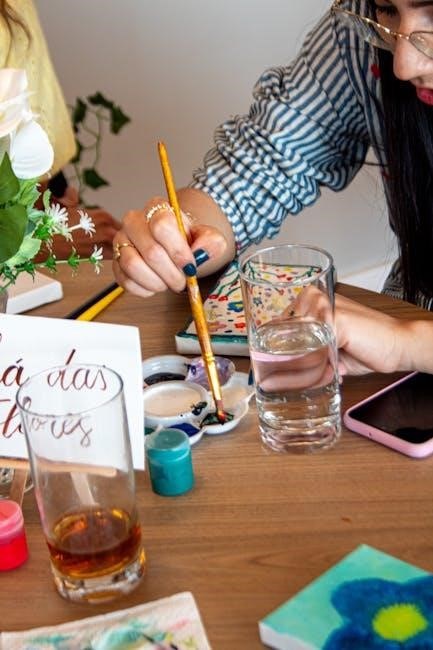
Advanced Techniques

Advanced watercolor techniques like layering, lifting, drybrush, and spattering enhance artistic expression. These methods allow for intricate textures, dynamic effects, and precise control, elevating your work to new creative heights with stunning visual impact and depth.
Layering
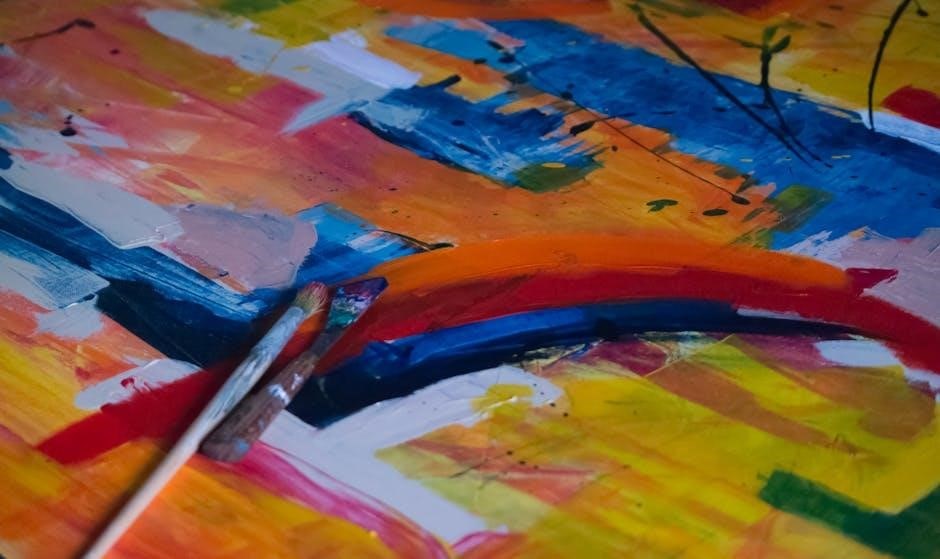
Layering is a cornerstone of advanced watercolor techniques, enabling artists to achieve depth, luminosity, and intricate details. By applying multiple thin washes of paint, artists can build up colors gradually, allowing each layer to dry before adding the next. This method is particularly effective for creating atmospheric effects, such as soft skies or distant landscapes. Layering also allows for subtle shifts in color and tone, enhancing the overall dimension of a painting. When using this technique, it’s crucial to work patiently, as rushing the process can lead to muddying the colors. Layering is ideal for capturing delicate transitions, such as the soft blending of light and shadow or the nuanced hues of foliage. With practice, this technique becomes a powerful tool for adding complexity and emotional depth to watercolor artworks, making it a favorite among both beginners and seasoned artists exploring the medium.
Lifting
Lifting is a versatile watercolor technique used to remove paint from the paper, creating highlights, lightening areas, or correcting mistakes. For wet paint, a clean, damp brush or soft cloth can gently blot or lift the pigment. For dry paint, a damp brush, sponge, or kneaded eraser is used to carefully remove the color. This technique allows artists to refine their work, adding subtle details like the sparkle on water or the soft edges of leaves. Lifting is particularly useful for creating delicate, ethereal effects and restoring areas of the paper to their original brightness. When lifting, it’s important to work gently to avoid damaging the paper. Patience and control are key, as excessive scrubbing can harm the surface. Mastering this technique enables artists to enhance and refine their watercolor paintings, achieving the desired balance of light and color in their compositions.
Drybrush
Drybrush is a watercolor technique that creates textured, rough effects by dragging a nearly dry brush across the paper. Load the brush with paint, then wipe off most of it on a paper towel. Drag the brush lightly over the surface, allowing the bristles to skip and catch, producing a broken, jagged effect; This technique is ideal for depicting natural textures like tree bark, stone, fur, or grass. The drybrush method enhances the tactile quality of your painting, adding depth and visual interest. It’s particularly effective for capturing the roughness of organic subjects or creating dynamic, expressive backgrounds. To achieve the best results, use high-quality brushes with stiff bristles and experiment with different pressures and angles. Practice this technique to master its unpredictable yet captivating outcomes, which can elevate your watercolor paintings with unique, lifelike textures and details.
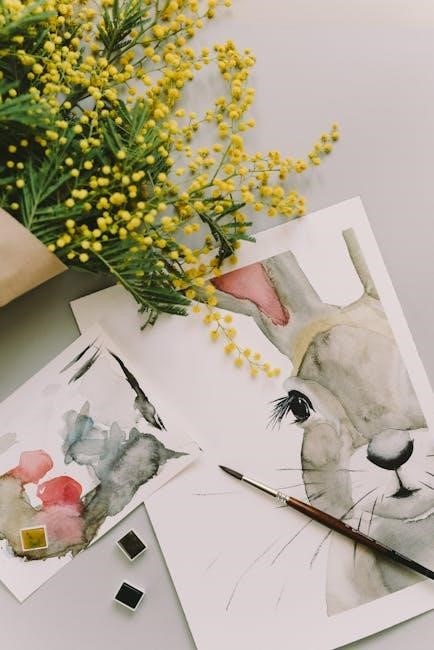
Spattering
Spattering is a dynamic watercolor technique that adds texture and visual interest by flicking or tapping paint onto the paper. Using a brush loaded with paint, flick your wrist or tap the bristles to create small, scattered droplets. This method is ideal for capturing elements like rain, snow, or foliage. To refine the effect, experiment with varying paint consistency and brush angles. Spattering can also be used to suggest movement or energy in your artwork. For precise control, try using a toothbrush or an old brush with stiff bristles. This technique is particularly effective for creating natural, organic textures and adding spontaneity to your paintings. By mastering spattering, you can introduce unique, unpredictable elements that enhance the visual appeal of your watercolor compositions. Practice this technique to achieve expressive, lively effects that bring your artwork to life with dynamic energy and texture.

Additional Resources
Explore comprehensive PDF guides, online tutorials, and recommended books to enhance your watercolor skills. These resources offer step-by-step techniques, exercises, and expert advice to master the art of watercolor painting effectively.
Recommended PDF Guides
Discover a wealth of knowledge with comprehensive PDF guides dedicated to watercolor painting. Titles like Watercolor Painting Techniques PDF: A Comprehensive Guide offer detailed insights into mastering both basic and advanced techniques. These guides provide step-by-step tutorials, exercises, and expert tips to enhance your skills. From understanding materials and color theory to mastering layering and lifting, these resources are invaluable for artists of all levels. Beginning Watercolor is another excellent guide, focusing on foundational techniques and practical applications. Many PDFs include demonstrations for painting landscapes, portraits, and botanical subjects, making them versatile tools for creative exploration. Whether you’re a novice or an experienced artist, these guides empower you to unlock the full potential of watercolor painting with clear instructions and inspiring examples.
Online Tutorials
Enhance your watercolor skills with a wide range of online tutorials designed to guide you through various techniques and projects. These resources often complement PDF guides, offering visual demonstrations and step-by-step instructions. Many tutorials focus on specific skills, such as mastering washes, wet-on-wet, and layering, while others explore creative projects like painting landscapes, botanicals, and portraits. Platforms like YouTube and art education websites provide accessible lessons for artists of all levels. Tutorials frequently include tips on color mixing, brushwork, and troubleshooting common challenges. Whether you’re refining basic techniques or exploring advanced methods, online tutorials offer a flexible and engaging way to learn. They also often feature downloadable resources, including PDF guides, to support your practice. With the convenience of online learning, you can progress at your own pace and enjoy the freedom to revisit lessons as needed.
